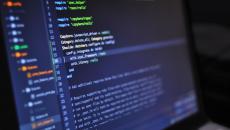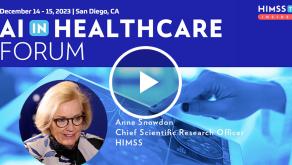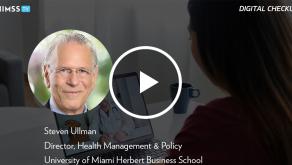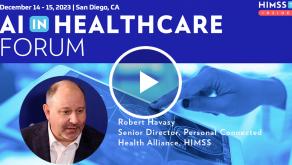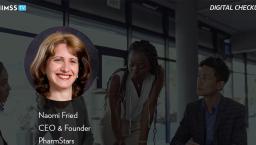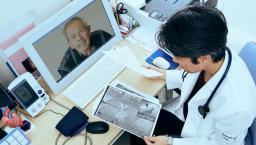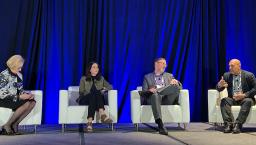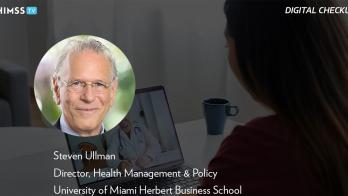A guide to connected health device and remote patient monitoring vendors
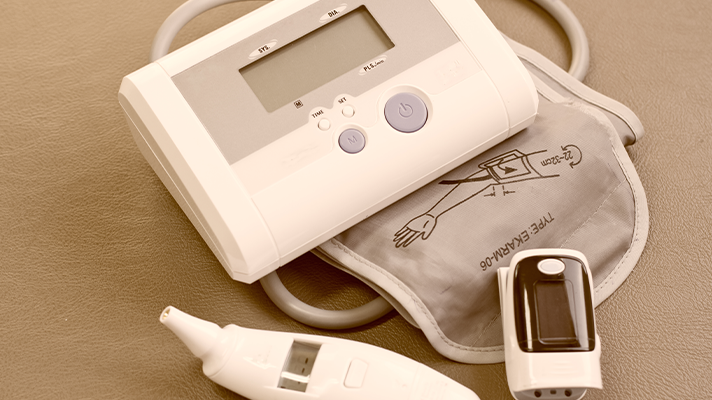
In an age when nearly everyone is digitally connected in some way – even many senior citizens, who are often characterized as technophobic – it only makes sense that the healthcare industry is seeing a lot of connected health devices and remote patient monitoring (RPM) technologies.
Connected health devices run the gamut from wearable heart monitors, to Bluetooth-enabled scales, to Fitbits. They provide health measures of patients and transmit them back to providers – or in some cases are reported back to providers – to facilitate healthcare decisions from afar. Remote patient monitoring technologies are akin to telemedicine technologies, since they automatically observe and report on patients, often with chronic illnesses, so caregivers can remotely keep tabs on patients.
In the middle of the COVID-19 pandemic, connected health and RPM are more important than ever, because they enable physicians to monitor patients without having to come into contact with them, thus preventing the spread of the novel coronavirus. They also keep patients with less severe cases out of hospitals, so preserving precious bed space for patients with severe cases. Hospitals across the nation are using connected health and RPM to great effect during the pandemic.
To help healthcare CIOs, CMOs and other leaders find connected health devices and RPM technologies, Healthcare IT News has compiled this comprehensive listing of vendors. Here you will find concise descriptions of the companies and their products. And the list will continue to be updated over time.
AltumView Systems
The company develops a smart medical alert system for senior care, which includes the Cypress smart visual sensor, cloud server and mobile app. The sensor is a smart IOT device with a powerful AI chip, which runs advanced deep learning algorithms to monitor seniors’ activities. When emergencies such as falls are detected, the sensor sends instant alerts to family members or healthcare workers. To protect users’ privacy while visualizing the incidents, the alerts include stick-figure animations of the incidents instead of raw videos, making it suitable for bedrooms and bathrooms.
Other features of the sensor include: face recognition, gesture recognition (seniors can seek help by waving a hand to the sensor), geo-fence (to alert caregivers when dementia patients leave the safe zone), voice calls, and statistics of daily activities to keep track of seniors’ health over time. It also has a built-in fall risk assessment feature, which allows seniors to perform fall risk assessment at homes, instead of going to the hospitals. In the future, the company will develop gait analysis algorithms for early diagnosis of Parkinson’s disease and dementia. The system also provides a cloud API, which can integrate other sensors into the system, or integrate the Cypress sensor into other systems.
The AltumView system can be useful to senior care facilities, seniors living at homes (especially those who live alone), and hospitals. In the COVID-19 pandemic, seniors are the most vulnerable. Due to the social distancing requirements, labor shortage and more challenging working condition for staff, it is very difficult for seniors to receive high quality of service using existing systems, which puts seniors’ safety at risk. Therefore, there are growing demands for smart devices to take care of seniors.
Babyscripts
Babyscripts is a virtual maternity care platform that enables obstetrics providers to deliver a new model of prenatal and postpartum care. Through the use of a mobile app and remote patient monitoring tools, Babyscripts has reduced the current prenatal in-person visit schedules from 12-14 to 4-6 for pregnant patients, the vendor contended, enabling providers to transition care outside of the clinic by means of continuous digital touchpoints. Babyscripts targets the gaps in maternal care (particularly for at-risk populations), the OB/GYN shortage, and the rising rates of maternal mortality through a digital point-of-care system.
Along with the Babyscripts myJourney app, patients receive a “Mommy Kit,” which includes FDA-approved remote monitoring tools such as blood pressure cuffs and weight scales. The app directs patients to take their blood pressure, weigh in regularly, and monitor glucose as appropriate so that issues such as high blood pressure or elevated blood sugar can be identified by their doctor in real time. Providers are able to collect more data than typically captured in the clinic, and are alerted to abnormal data points through a trigger system.
Patients also have access to research-based educational materials, gestational age appropriate content, e-mail campaigns and satisfaction surveys, as well as practice-specific content fully customizable by the provider (available in English and Spanish). The app drives patient engagement and support through daily inspirations, tips and reminders. Additionally, the vendor offers bi-directional chat functionality through the app to facilitate care coordination, as well as surveys to assess mental health and social risk.
While developing the program with clinicians and traditionally selling directly to providers of care (OBGYNs, midwives), Babyscripts has expanded its client base to include payers to begin to try to solve some of the structural issues with care coordination, including problems of reimbursement. Babyscripts services all providers of prenatal or postpartum care, the payers who manage those pregnant members, and all support resources involved with ensuring that a patient receives proper pregnancy care, such as social workers and community leaders.
Bardy Diagnostics
Bardy Diagnostics is a digital health and remote patient-monitoring company focused on addressing a long-standing complaint by cardiac electrophysiologists and cardiologists regarding their frequent inability to clearly distinguish the P-wave on ECG strips of existing monitors. The company’s Carnation Ambulatory Monitor (CAM) Patch is a P-wave-centric ambulatory cardiac monitor and arrhythmia-detection device that also is designed to improve patient compliance for both adults and children through its lifestyle-enabling form factor.
To overcome signal-to-noise limitations with short patch vectors, the CAM Patch employs a novel circuit design and uses advanced compression algorithms to process the signal, ensuring clear P-wave recording. These technological advancements, combined with the placement of the CAM Patch over the sternum, creates an aVF-like lead, optimized for P-wave signal capture, in addition to being sensitive enough to capture the higher-amplitude QRS signal.
Designed for simple ease of use and discretion, and with women’s comfort in mind, the hourglass-shaped CAM Patch is placed on the center of the chest, directly over the heart, for optimum ECG signal collection up to 14 days. The proprietary technology of the CAM Patch is able to detect and clearly record the often difficult-to-detect P-wave, the signal of the ECG waveform that is essential for accurate arrhythmia diagnosis. The result is a high-sensitivity P-wave monitor that is comfortable for all patients during extended wear.
The CAM Patch can serve as a remote patient-monitoring system during the COVID-19 pandemic, the vendor said. The quickly evolving COVID-19 public health emergency has warranted the growing use of telehealth and non-invasive remote-monitoring devices to facilitate patient monitoring while reducing patient and healthcare-provider contact and possible exposure to the virus.
Access to remote cardiac monitoring is crucial during this pandemic, especially for patients with COVID-19 who are being treated with Hydroxychloroquine, Azithromycin, or any other experimental or investigational medications that have been known to prolong the QT interval, potentially leading to Long QT Syndrome, Torsades de Pointes or other potentially lethal cardiac arrhythmias, the vendor explained.
Biofourmis
Biofourmis’ remote patient-monitoring and AI-based analytics technology, Biovitals, provides personalized predictive care by leveraging active and passive data collected from clinical-grade patient wearables that continuously monitor more than 20 physiological parameters, as well as patient-captured data from a mobile app.
Biofourmis’ primary therapeutic focus areas include heart failure and other cardiometabolic disorders, pain and oncology. And now its Biovitals Sentinel technology is being used to monitor quarantined and hospitalized patients in several countries with suspected or confirmed COVID-19. The Biofourmis armband wearable, Everion, is worn 24/7, and captures the patient’s temperature, blood oxygenation and numerous other physiologic signals in order to detect signs of decompensation, while the patient also reports any symptoms to their healthcare provider through a mobile app.
Biofourmis’ digital therapeutics are used for RPM across three primary healthcare stakeholder groups: health systems, payers and pharmaceutical companies. Typically, the health systems and payers work together in a value-based care arrangement that involves shared risk and reward. Clinicians at health systems typically prescribe Biovitals for three to six months of home monitoring following hospital discharge. The platform uses AI and machine learning that combine sensor data from the wearable with the patient’s medical history to create a unique profile that is updated in real time throughout the monitoring period.
The AI continuously runs algorithms on the patient’s profile to predict decompensation. Biovitals’ AI-based treatment algorithms then enable software-based therapeutic interventions that signal to clinicians what they should do next to intervene, in order to prevent critical events that would otherwise lead to hospitalizations or visits to the emergency department.
The treatment algorithms are personalized for each patient based on machine learning and ensure the right drug dosages and treatments for the right patient at the right time. For example, the Brigham Home Hospital program leveraged Biofourmis’ AI-based technology to improve outcomes while lowering costs by 38%, the company reported.
Pharmaceutical companies use Biofourmis’ RPM and AI-based predictive analytics in three ways: 1) Platform licensing for digital or virtual clinical trials; 2) with a “pill plus” model, in which Biofourmis’ technology augments the value of therapy by wrapping digital therapeutics around existing pharmaceutical therapy to increase value and drive better adherence and outcomes; and 3) as a companion therapeutic, in which Biofourmis establishes partnerships with pharma companies early in the drug-development process – even before phase 2 trials begin. Then, once the drug is approved, it can be prescribed only in conjunction with Biofourmis’ digital therapeutics technology.
Biotricity
Biotricity focuses on remote patient monitoring and builds diagnostic and post-diagnostic systems for chronic conditions, starting with cardiac. The company has built a core technology platform that encompasses cellular IoT, AI, sensors and the cloud to transform the treatment process. Biotricity believes the future of healthcare technology is in remote delivery, remote diagnostics and remote care management, led by connected smart medical devices.
Biotricity tackled remote cardiac diagnostics first, as cardiac disease is the leading cause of death across the globe. The company entered the remote monitoring space by developing Bioflux, an FDA-cleared and reimbursable single-unit mobile cardiac telemetry (MCT) device for arrhythmia detection that combines cellular IoT, beat and arrythmia-detecting sensors with AI-enabled analytics in real time, providing continuous analysis of ECG data to enhance testing and diagnostics for patients with cardiovascular disease.
Biotricity currently is completing the development of its Biotres device, a 3-in-1 device for arrhythmia analysis that delivers a hybrid solution for patients with less serious cardiac conditions who still require active monitoring. Biotres has no lead wires but advanced beat and arrythmia autodetection with the ability to transmit the device data immediately to physicians and is rechargeable, facilitating easy lifestyle and care management for those who need clinical supervision.
Blue Spark Technologies
The vendor’s TempTraq is a Bluetooth-enabled wearable continuous temperature monitor in the form of a one-time use, disposable soft patch. For up to 72 hours, TempTraq senses, records and transmits body temperature data via Bluetooth to a smart device (Apple or Android) running the TempTraq app. TempTraq measures under-the-arm “axillary” temperature and this is converted to an oral temperature, which is displayed in the TempTraq app.
TempTraq Connect is a cloud service supported by the Google Healthcare Cloud Platform that enables patients and caregivers to monitor body temperature from anywhere. Data from the secure server can be integrated via HL-7 standards with electronic health records, central nurse workstations, patient bedside monitors and mobile devices to provide clinicians with temperature data visualization and mapping of data to the desired patient record fields. The system is scalable and can support a single hospital or a multi-hospital/physician group health system. The system has been cleared by the FDA, CE and TGA.
TempTraq currently is being used in a number of applications where real-time continuous temperature monitoring for fever detection is warranted in oncology, clinical trials and where patients are undergoing immunosuppressive therapies.
And TempTraq recently has been deployed by University Hospital in Cleveland, Ohio, to monitor temperatures of frontline healthcare workers treating COVID-19 patients.
Cardiologs
Cardiologs’ mission is to democratize expert cardiac care through medical-grade artificial intelligence and cloud technologies. Cardiologs offers device-agnostic, cloud-based arrhythmia diagnostic software powered by medical-grade AI to streamline ECG analysis. Built on a growing database of more than 4 million ECG recordings, the software is designed to automate 80% of the labor required to perform an expert-level diagnosis.
The diagnosis of arrhythmia, including Afib, requires timely, accurate ECG analysis. ECG analysis remains challenging for non-experts and time-consuming for experts, the vendor said. Holter and extended Holter ECG signals, which record the electrical activity of the heart between 1 and 30 days, and even up to a few years in the case of implantable devices (ILR), generate vast amounts of data that have to be analyzed manually by experts, which is a time-consuming and labor-intensive process that can result in elevated costs, treatment delays and variable quality.
To reach expert-level diagnosis, Cardiologs leverages deep learning technology to capture on the ECG the ventricular and atrial rhythms, analyzing the P wave like an expert would, making it more specific than traditional software, in which ECG analysis algorithms traditionally rely on the RR interval only, the vendor contended.
The Cardiologs system acts as a one-stop shop for ECG analysis, as it is device agnostic, allowing users to use a single platform to analyze multiple Holter devices or patches without the need to be mastering several different types of software, the vendor said. The stakeholders involved in the arrhythmia diagnostic pathway are connected through the Cardiologs hub platform, which is accessible on the cloud, and thus can be accessed at any time, from any computer, and to any user simultaneously, offering a change in paradigm that can simplify diagnostic workflows, the vendor concluded.
CAREMINDr
CAREMINDr is a health IT communications company that provides mobile-enabled remote patient-monitoring systems that give physicians the ability to enroll their patients in condition-specific “journeys,” such as for diabetes and hypertension. Through the company’s app, physicians can automatically check in on patients in between face-to-face visits on a clinically relevant schedule that the physician’s practice controls, based on the patient’s conditions. In turn, patients report biometric, objective and subjective data on their health status and social determinants of health via a patient-facing app.
The technology often is supported by home medical devices such as glucometers, blood pressure cuffs, thermometers and pulse oximeters. These check-ins establish an accountable dialogue for patients with providers, to nurture trust and engagement. The mobile remote patient-monitoring approach is designed to enable physician practices, health systems and payers to reduce emergency department visits and hospital admissions by detecting health deterioration earlier, while encouraging care-plan adherence through repeated, automated contact with the patient that encourages their action and response.
The vendor’s technology is used for physiologic monitoring of patients with a variety of needs, including chronic care management and post-hospital discharge recovery. In addition, the company recently launched a COVID-19 monitoring system to support the management of patients with related symptoms, or who have tested positive for COVID-19 and are self-quarantining at home with mild symptoms.
A similar workplace monitoring system has been launched to help employers manage the return of employees to the workplace, in order to ensure any early signs of possible infection are quickly flagged. This customized journey requires employees to report their temperature and any other potential COVID-19 symptoms via the CAREMINDr app from home at least an hour before they are scheduled to work.
Any abnormal responses or vital stats are tagged and reported to: a healthcare organization partnering with the employer, a clinician on the employer’s staff or a human resources professional for a referral to a COVID-19 testing site to confirm an infection and prevent spreading the virus in the workplace. By tracking employees with potential COVID-19 infection, data also can identify communities that may become outbreak hot spots, and therefore may warrant a broader community health response.
CoachCare
The CoachCare platform powers health clinics across many specialties, including weight loss, bariatric surgery, pain management and chiropractic care, and other clinics looking to incorporate a comprehensive and customized virtual health monitoring system into their practice.
CoachCare enables clinics to gain 24/ 7 insight into their patients’ lives outside the four walls of the clinic through a custom-branded patient mobile app, clinical dashboard and proprietary connected health devices, including a Bluetooth scale and activity tracker. The system is scalable and customizable, delivering a clinic’s unique protocol and focusing on the data the clinic needs at the moment it needs it.
CoachCare’s suite of virtual tools, including real-time messaging, video conferencing and content sharing, helps to emulate an in-person visit from the comfort of the patient’s own home. The platform also provides all the features required to implement a remote patient monitoring system, so a clinic can remotely monitor patients from home while maximizing insurance reimbursements. Other features include scheduled, automatic communications between clinic and patients, personalized program tracking, scheduling, alerting, and reports.
Current Health
Current Health offers an AI-enabled remote patient-management platform. The platform continuously monitors the body across a range of vital signs, and augments this data with an ecosystem of devices to capture the broadest picture of human health and the patient’s symptoms. Current Health then uses AI to identify those at risk of disease and proactively alert physicians to potential issues, driving earlier intervention and treatment. The platform also enables health systems to determine how to best allocate resources – such as healthcare workers and beds – and contains the spread of infectious disease by managing care for lower-risk patients remotely.
For these reasons, Current Health can be valuable to health systems as they navigate the surge of patients requiring care due to COVID-19, the vendor said. Currently, dozens of health systems are using the platform to monitor and manage hundreds of patients infected with COVID-19 at home and in the hospital, the vendor reported. As a result, the Current Health team has access to anonymized vital-sign data and raw physiological sensor data – for example, temperature, heart rate, oxygen saturation, activity and posture – for hundreds of patients infected with the virus, as well as thousands of patients not infected with the virus.
Current Health is leveraging this data to better understand how the coronavirus presents and evolves across diverse populations via a partnership with the Mayo Clinic. Through this collaboration, the company is helping add to Mayo Clinic’s major advancements in accelerating COVID-19 detection and diagnosis, and in further efforts to understand and treat this disease, the vendor said. The company is collecting more data every day that will help in this effort, and Mayo Clinic is investing significant resources into COVID-19-related research.
Datos Health
Datos Health provides a remote care and telehealth platform that allows patients to be monitored and cared for out of the hospital setting. Datos uses advanced analytics and works agnostically across any treatment protocol, patient profile, data source, wearable and medical device, allowing automated detection, management and prediction of irregular symptoms. The platform enables implementation of remote care within existing workflows.
During COVID-19, Datos has allowed health systems to directly and continuously connect patients with their sources of medical care. Its FDA-cleared remote care system is specifically designed to support hospitals across the world to mitigate the spread of COVID-19 and prevent them becoming overwhelmed by helping keep suspected coronavirus patients, and those infected but not requiring hospitalization, at home while still providing them with optimal care. The Datos COVID-19-specific telemedicine package already is in use at Sheba Medical Center, Israel’s largest hospital, and has begun implementations in U.S. health systems.
The technology additionally provides health systems with a private, cloud-based interface of the Datos platform anywhere in the world. Optional extras include services delivered via a text message with links to web pages for reporting vitals management, survey distribution and video calls.
EarlySense
EarlySense offers contact-free continuous monitoring and AI-powered predictive analytics. EarlySense’s patient monitoring system is used in health facilities to assist with early detection of patient deterioration and empower health teams to help prevent adverse events.
The EarlySense sensor, placed under the patient’s mattress, tracks multiple data points every second (more than 100 data points per minute), including respiratory rate, heart rate and movement without ever touching the patient. The integrated sensor uses artificial intelligence and predictive analytics to notify care teams of clinical changes that may be detected hours before an event becomes critical. As a result, health teams can take action to help reduce adverse events, including code blue events that are a result of cardiac or respiratory arrest, preventable ICU transfers, patient falls, pressure ulcers, and hospital readmissions.
These actionable health insights are proving especially useful for healthcare facilities during the current coronavirus crisis, as the EarlySense sensor transmits real-time patient data for the early detection of clinical changes to a display outside of the patient’s room, limiting the need for staff to gown up and enter isolation areas. As a contact-free monitoring solution, there are no leads or other wearable devices to adjust or to touch the patient’s body. Additionally, EarlySense’s technology will be available later this year in a compact, cloud-based module that will enable caregivers, telehealth companies and a variety of product developers to integrate and expand their remote patient monitoring capabilities.
Eko
Eko’s telehealth and remote patient-monitoring platform powers virtual cardiac and pulmonary exams by facilitating stethoscope and ECG live streaming. The platform has embedded video conferencing, or works alongside the video conferencing platform that a health system has in place. It also equips providers with Eko’s FDA-cleared AI to assist in remote screening for AFib, heart murmurs, tachycardia and bradycardia.
The system can be used to conduct telehealth visits between two or more clinics. A provider present with the patient at one location – a nursing home, community clinic, etc. – can share a stethoscope live stream with a consulting provider so they can hear the patient’s body sounds, assess rhythm strips and provide potentially lifesaving advice based on their exam findings.
The platform is also designed for direct-to-patient telemedicine. Using Eko, a patient will self-operate the DUO stethoscope from home and stream their body sounds to a listening provider, likely at a virtual care center or hospital. The DUO is a combined digital stethoscope and 1-lead ECG specifically designed for patients to operate at home under the remote supervision of a healthcare provider responsible for interpreting the data. The listening provider will be able to hear high-quality heart, lung, carotid and other body sounds, analyze the patient’s single lead rhythm strip, and leverage the AI.
Eko is used by telehealth departments across the country, including Sutter Health, the University of Pittsburgh Medical Center, the University of Alabama Medical Center, the University of Arkansas for Medical Sciences, Spectrum Health and the University of Rochester Medical Center.
Empatica
Empatica makes wrist-worn medical wearables, software and biomarkers for the continuous monitoring of health conditions. Its Embrace smartwatch has received clearance by the FDA in the field of neurology. As a response to the COVID-19 pandemic, Empatica launched Care, a remote health monitoring platform that is built on its existing technology. The Care platform wirelessly collects and streams vital signs to a user-friendly app and web dashboard, where they can be visualized and subsequently provide clinicians, researchers, caregivers and employers with information on a user’s well-being and whether intervention is needed.
The physiological data is gathered using Empatica’s legacy E4 wristband. The E4 is CE-certified, noninvasive, and already used by thousands of researchers in studies on human behavior and physiology in real-world settings. It continuously collects key vitals from the wrist like heart rate, heart rate variability, peripheral temperature and respiratory rate, using a PPG sensor, an infrared thermopile, a 3-axis accelerometer and an EDA (electrodermal activity) sensor.
The data collected by the E4 is transmitted via Bluetooth and visualized on the Care App, a dedicated patient app that can be downloaded on any phone running iOS or Android. The app helps patients keep an eye on their own health and the status of the system, while it simultaneously sends the information in real time to the Care Portal, a web dashboard running on Empatica’s HIPAA-compliant cloud.
The Care Portal can be used by a clinician, researcher or caregiver to quickly and securely access the data collected by multiple users, visualize it, and compare it against trends. It has an intuitive workflow and has been designed to reflect the set-up that one would find in a multisite environment, like a hospital, a clinical trial or a workplace. The Care Platform can be combined with Empatica’s custom digital biomarkers, which can provide additional insight into patient physiology, and are particularly useful when monitoring patients with a specific set of conditions.
Fitbit
A famous consumer brand, Fitbit’s array of fitness trackers and smartwatches have seen use in healthcare settings as well. The devices’ sensors capture a range of wellness metrics such as step count, heart rate, active minutes, sleep time and sleep stages, and regularly sync these readings to a paired device.
In 2019, Fitbit unveiled a more data-driven personal-health subscription service for consumers that, among other features, generates personal reports that a user can download and share with their physician, nutritionist or personal trainer. And on the topic of apps, several of its devices support third-party software offerings that open more doors for health data collection or monitoring – for instance, a photoplethysmography (PPG)-based feature enabling nighttime atrial fibrillation readings.
Looking forward, the company recently announced the launch of its own large-scale study that will combine passive, continuous heart rate readings through the devices’ PPG sensor and a proprietary algorithm to flag potential cases of atrial fibrillation for clinical follow-up. In addition, the company is awaiting FDA approval for an onboard ECG feature for spot detection of atrial fibrillation.
GrandPad Connected Care
GrandPad provides a variety of connected care offerings, including Daily Connect, a remote care system that integrates with the GrandPad tablet to deliver well-being data to remote caregivers. GrandPad Daily Connect is designed to detect abnormalities in the physical, cognitive and emotional well-being of older adults and wirelessly transmit data and insights to caregivers to determine if interventions are needed when values are outside the normal range for the older adult.
GrandPad Daily Connect integrates a wearable device designed to track sleep and steps; a body weight scale; and a device that records blood pressure, pulse ox, body temperature, heart rate and respiration in a simple, safe and reliable way. All devices connect via Bluetooth or Direct Cloud Connect.
These connected devices can be integrated separately into the GrandPad tablet or bundled as part of GrandPad Daily Connect for caregivers. GrandPad comes with a telehealth platform with video capabilities for virtual care. It can integrate with other telehealth platforms.
GreatCall
The vendor’s Lively Mobile Plus is a medical alert device that helps keep older adults safe and independent by connecting users to GreatCall’s 5Star Urgent Response agents with one touch of a button. The device is equipped with added fall detection technology when paired with the Ultimate Health and Safety Plan, automatically connecting to an agent when a fall occurs.
The Lively Mobile Plus has GPS technology provided by Snapdragon Wear 1100 Platform, enabling reliable and accurate locating in emergency situations. The Lively Wearable2 is a mobile medical alert device that connects older adults to a 5Star Urgent Response Agent in any medical emergency via Bluetooth connectivity, and connects to the user’s smartphone through the Lively App.
5Star Urgent Response is an emergency service exclusive to GreatCall products that immediately connects device users to a trained, certified IAED 5Star Agent in the event of an emergency. Device users can press the 5Star button on their phone or wearable to immediately be connected to a 5Star Urgent Response agent, based in one of GreatCall’s three Caring Centers (located in Carlsbad, Reno and San Antonio). Agents will confirm users’ location, evaluate the situation and stay on the line until the situation is resolved.
The Lively Home is a passive remote monitoring system that leverages data and predictive analytics to help keep older adults safe and healthy. The Lively Home is unobtrusive, requires little to no active user engagement and offers data-driven insights on activities of daily living (ADLs) to caregivers.
These data-driven insights are beneficial in managed care and assisted living facilities because they offer additional context to caregivers and help them scale care and reallocate time and resources as needed to efficiently care for a larger population of patients at once. In addition, the information gathered by passive remote monitoring systems, paired with predictive analytics, is helping caregivers move to a preventive care approach.
Best Buy Health also offers on-demand social work services, including medication management. Through the acquisition of Critical Signal Technologies in 2018, its 24/7 Caring Centers can provide medication reminder and isolation/loneliness check in calls to older adults, as well as offer triage and wellness support services.
Best Buy Health also offers a monitored dispensing device to drive patient compliance and simplify in-home care. Monitored dispensing devices hold up to 28 consecutive doses of medication and can dispense one to four times each day (depending on individualized protocol) and come equipped with an audible alarm and flashing red light during dispensing.
Hello Heart
Hello Heart is a hypertension- and diabetes-monitoring system that empowers people to track, understand and improve their health. Users are able to build healthy monitoring habits using blood pressure cuffs and glucometers. They improve their health in real time with an easy-to-use smartphone application, and catch risk in time.
Employers and payers may offer telehealth options that allow the team member to meet with their doctor via video. However, unless the patient is using an FDA-validated monitoring system to track blood pressure and glucose levels, the doctor cannot diagnose, prescribe medication or identify life-threatening situations, the company said. Hello Heart offers an FDA-approved blood pressure monitor coupled with an app that tracks blood pressure readings and glucometers that track blood glucose levels, weight and physical activity. It alerts for out-of-range hypertension to catch serious risks in time. It also provides medication-adherence tools.
Users of Hello Heart’s remote-monitoring system can provide their vital signs report to their physicians securely and privately. During a video telehealth call, the doctor, armed with this data, can detect serious conditions and proactively recommend treatment when needed. Hello Heart reports that users now are monitoring their health more than twice as often since being confined to their homes during the pandemic: 79% of users that had used Hello Heart once per week now use it two to four times a week.
Hinge Health
Hinge Health is a digital care system for people with chronic musculoskeletal (MSK) conditions such as back or joint pain. Hinge Health combines sensor-guided exercise therapy, remote one-on-one health coaching, and weekly education articles to address chronic MSK pain. Designed by physicians and physical therapists, the treatment program is delivered remotely using mobile and wearable technology.
Based on expert-recommended non-surgical care guidelines, Hinge Health developed digital exercise pathways to help patients with back and joint pain avoid unnecessary surgeries. Offered as a healthcare benefit by employers, eligible members who enroll in the Hinge Health program receive a welcome kit that includes an Amazon Fire tablet with the Hinge Health application pre-loaded and wearable motion sensors.
To boost engagement and adherence in the program, members also are paired with a health coach for unlimited one-on-one coaching through phone calls, text messages, e-mail and the Hinge Health app. In addition, enrolled members have one year of unlimited access to all of Hinge Health’s Digital Care Pathways for back, knee, neck, shoulder and hip.
iRhythm Technologies
iRhythm is a healthcare technology company that clinically diagnoses cardiac arrhythmias by combining wearable biosensing technology with cloud-based data analytics and machine learning capabilities. iRhythm’s Zio platform is a complete ambulatory cardiac monitoring system designed to meet patient needs across the risk spectrum, and includes a small, water-resistant wearable biosensor encasing a chip and two electrodes, collecting an uninterrupted, continuous electrocardiogram recording.
The FDA-cleared Zio device continuously logs heartbeat data for up to 14 days to analyze a patient’s heart rhythms. With more than 125 million hours of heartbeats logged from 500,000 patients and counting, iRhythm has a massive heart rhythm database, the company said. According to a paper published in Nature Medicine, iRhythm’s deep neural network uses this data to identify arrhythmias as accurately as expert electrophysiologists and cardiologists, the company contended. Once analyzed, all data then is curated by ECG experts. A cloud-enabled portal, Zio Suite, offered as a desktop and mobile application, provides the report to physicians in a time-effective way, allowing them to focus on patients.
Zio helps capture data for the 51% of patients who have their first symptom-triggered arrhythmia after 48 hours. Zio is designed to maximize patient comfort and compliance, which allows the biosensor to collect continuous, uninterrupted data, resulting in a 99% median analyzable time, the company explained. iRhythm has two main product offerings: Zio XT and Zio AT, the former for lower-risk heart patients and the latter for those who are higher-risk and require monitoring that is near real-time and more long-term.
The Zio monitor is applied to a patient’s chest in the hospital or at home. Once applied, if a patient feels a symptom that may be an unusual heart rhythm, they press the top of the patch and briefly describe it in the Zio patient portal application. After wearing the monitor for the prescribed wear time, the patient removes it and mails it back to iRhythm, where the company’s patch-intake centers compile the data for analysis by the DNN and curated by ECG experts to produce a customized final report for physicians.
The final Zio report gives physicians a comprehensive look into their patient’s heart rhythm data, including: daily and total atrial fibrillation burden, daily and total ectopy burden, symptom/rhythm correlation, most relevant heart rhythm strips, heart rate trends, preliminary interpretation and key findings, and PVC burden and morphologies. The results are included in an actionable and comprehensive final patient report.
iRhythm is supporting physicians and patients during COVID-19 by expanding its home enrollment offering so more patients can receive and apply the patch at home and avoid potential exposure by going to a clinic or hospital. This also reduces physician exposure to the virus. The company also is working with Montefiore Health System in New York to monitor heart rhythms in COVID-19 patients in the hospital and remotely.
Because this technology provides remote readings, Montefiore can care for patients in various units across all three of their campuses from one centralized location, conserving resources while also providing high-level care to their patients. Upon discharge, the patient can continue wearing this device and be observed by a Montefiore cardiologist, providing additional monitoring in the crucial days immediately following discharge.
Livongo
Livongo provides an integrated chronic condition management platform for diabetes, hypertension, weight management, diabetes prevention and behavioral health. The platform uses cellular-connected technology and remote monitoring to instantaneously collect health information. Using data science, Livongo offers its members digital recommendations based on their reading.
If a person registers a health reading that is out of range, a Livongo health coach will reach out to them within 90 seconds to make sure they are OK. Livongo members also can share their health information with doctors, their family, friends or other members of their care team, using the Livongo meter, app or web portal.
Through partnerships, Livongo also brings in data from continuous glucose monitors, electronic health records, pharmacy benefit managers and clinical laboratories. It then uses this data to offer more personalized recommendations on the platform.
Through telehealth partnerships, Livongo delivers a stepped care model that begins with digital coaching, followed by time with a Livongo coach, and can be escalated to a licensed telehealth professional when clinical intervention is appropriate. All three steps, including access to telehealth services, are available on the Livongo platform.
Medical Innovations
The company’s MiHealth Monitoring offering is designed to use evolving wearable technology to give healthcare providers insight into a patient’s health and recovery. Physicians are able to gain a better understanding of their patient’s chronic diseases by remotely monitoring a patient’s dynamic physiology.
MiHealth seeks to apply the art of medicine to the science of current and future wearable technology, the company said. By using derivative functions of standard Bluetooth-enabled medical devices and wearable technology, the company can asynchronously give physicians better insight into a patient’s day-to-day health and detect early perturbations of physiology, the vendor explained.
MiHealth’s iOS and Android smartphone apps provide text, voice and video communication to facilitate telemedicine. In addition, the MiHealth app allows scheduled and real-time patient self-assessment questions. Patient answers are displayed in easily interpretable graphics on a cloud-based dashboard. Patient education material in the form of images, documents and videos is pushed to patients through the app, as well.
The MiHealth provider dashboard is designed with clinical workflow in mind. It uses artificial intelligence to interpret and display remote-monitoring data, which strikes a balance between alerting about concerning trends and avoiding alarm fatigue, the company said. Intuitive dashboard workflow allows the healthcare provider to dive deep into physiologic data with helpful graphic trend analysis.
Myia
Myia is an intelligent health-monitoring platform for patients with chronic conditions. Myia’s platform ingests a wide range of real-world data from curated sensors and sources, transforming it through applied machine intelligence into actionable and objective clinical insights.
Integrating and curating a wide array of high-fidelity, third-party biometric sensors, Myia provides patients with a frictionless, consumer-grade experience focused on passivity of data, thus lessening the burden of technology for those who lack means and capacity.
Harnessing the power of human data, Myia equips clinicians with the precise information they need to both prioritize critical patients and prevent unplanned medical events. Myia provides clinical teams with contextualized proactive information targeted directly into their EHR and workflow. This enables Myia to augment the ability of clinicians to better care for patients living at home with chronic conditions like heart failure, COPD, diabetes and hypertension.
Philips
Philips’ remote patient-monitoring technologies provide care teams with the tools they need to remotely track the health of their patients at home, collaborate with the patients’ doctors, and help detect problems before they lead to readmissions. Providers assign patients to specific care protocols and interventions that are tailored to condition or acuity level, which can include measuring vital signs, completing surveys, watching educational videos and participating in video visits with the virtual care team.
One product is called the eCareCoordinator clinical dashboard. The eCareCoordinator telehealth software platform allows clinicians to remotely monitor patients’ vital signs and send patients short surveys about their health status. This combination of objective data and subjective responses supports clinicians to make informed, timely care decisions.
It features patient and population management, connected care and collaboration across the enterprise, patient communication and engagement, patient empowerment to self-care, and tailored care plans.
Another product is called the eCareCompanion patient application. eCareCompanion is a telehealth application that patients access on a secure tablet at home and use to share health information with their care team.
With a screen tap, patients launch eCareCompanion, enter their password, and begin providing vital information to caregivers in a private and secure manner. Patients answer survey questions and enter requested measurements to enable the care team’s assessment. They are reminded of pre-assigned health tasks, and can view their recent vital trends, which helps them associate health behaviors with health trends.
PhysIQ
PhysIQ develops and deploys continuous remote patient monitoring systems for biopharma companies to use in clinical trials as well as to healthcare providers and payers seeking other ways to care for their high-risk patients. PhysIQ specializes in collecting and analyzing wearable biosensor data with a mission focused on extracting clinical insight from real-world continuous data streams using artificial intelligence.
To enable this vision of continuous RPM, the company has built out two sets of assets: 1) A device-agnostic IT platform specifically architected to efficiently process continuously streaming waveform data and vital signs, and 2) A portfolio of FDA-cleared AI algorithms that convert raw real-world biosignals into clinical insight. The company focuses on supporting clinical use-cases across both healthcare delivery and clinical trials and, as such, all software and analytics are developed and validated in accordance with medical-grade requirements.
PhysIQ is commercializing its system across two verticals within healthcare – clinical trials and healthcare delivery. Both are predicated on the same vision of passively collecting streaming biosensor data and converting it into insight. For clinical trials, these insights are being used to support efficacy and safety endpoints with the company’s accelerateIQ product. For healthcare delivery, physIQ is deploying its pinpointIQ product to help health systems and payers leverage wearable sensors to proactively monitor and care for at-risk patient populations.
Prevounce
Prevounce is a cloud-based platform that supports practices in their delivery of remote patient monitoring services as well as chronic care management, annual wellness visits and preventive services. Prevounce Remote Patient Monitoring gives practices the process, software and equipment (if desired) to provide RPM services to patients. The system is designed to integrate with many of the most popular EHR systems and fit into any medical practice workflow.
Implementation of and training on the Prevounce Remote Patient Monitoring system typically is completed within 48 hours. When practices add patients to the system and designate a device(s), Prevounce performs the initial patient outreach and education.
Practices can choose to provide their patients with Prevounce devices, which are shipped directly to patients. These devices use embedded cellular connectivity, and the only setup required by patients is to insert batteries and power on the device. The system currently supports monitoring of blood pressure, weight, blood glucose and pulse oximetry. Support for spirometry and electrocardiography is forthcoming.
Users of Prevounce Remote Patient Monitoring gain access to a range of features. Providers can choose to review data from patient devices in the system or their integrated EHR. Staff are automatically notified if a patient’s readings enter a specified caution or critical range, and reports can be customized to best suit a provider’s workflows. If providers choose to log time toward RPM management billing codes, Prevounce can automatically track this information to help ensure all requirements are met prior to billing. The Prevounce billing system generates a monthly report showing all billable RPM codes for each patient.
Prevounce Remote Patient Monitoring is compatible with PrevChek smart devices, as well as with many third-party devices and software. Practitioners can integrate the use of devices by other manufacturers, including those from Omron, iHealth and Dexcom.
Qardio
Qardio’s RPM platform incorporates connected diagnostic devices, a smartphone app, and a web-based dashboard for care provider access and review. Qardio’s proprietary devices include the QardioArm wireless blood pressure monitor and the QardioBase2 scale and body composition monitor. These devices relay data via the smartphone app for iOS and Android devices. Care providers review patient data via the web-based QardioMD dashboard. The platform also incorporates glucose, SPo2 and temperature from select third-party devices, or via patient entry in the app.
The RPM system enables patients to record and relay data from home or virtually anywhere. Patient data automatically is collected, analyzed and presented for review by care providers via the dashboard. The dashboard enables care providers to review large patient populations via “stoplight” groups where green equals stable trend, yellow equals a change in trend is detected, and red equals a significant change in trend requires attention.
QardioMD + VSI is an optional RPM service that employs the Visensia Safety Index (VSI) under license from OBS Medical. VSI is an AI-based clinical measurement that can identify patients at risk of significant deterioration before most physicians and nurses can, the vendor contended. For example, with blood pressure and heart rate from QardioArm, plus SPo2 from a compatible device – a VSI score can be an indicator of pre-symptomatic infection. When combined with the RPM platform, VSI enables care providers to make necessary interventions on a remote basis.
The QardioMD platform integrates with select EHRs.
Qure4u
The Qure4u patient-engagement platform connects patients and in-home remote patient-monitoring devices with caregivers to support the delivery of virtual care by physician practices, medical groups and Federally Qualified Health Centers. The company’s RPM efforts include device connectivity, RPM data dashboards and alerts, patient care plans, and full integration with multiple physician practice EHR systems.
Most patients under remote monitoring have overlapping chronic conditions and use multiple in-home devices. To accommodate data input from several devices, Qure4u uses a proprietary integration engine and open API approach. The company connects APIs from multiple RPM devices, including the most popular home monitoring-apps and devices covering all vitals needed, from blood pressure, pulse, blood sugar and oxygen saturation to temperature, weight, nutrition and sleep data. Data from any RPM vendor that offers API connectivity can be uploaded into the Qure4u platform.
Patients have their individual care plan and receive mobile alerts from the Qure4u application to encourage compliance with RPM reporting, receive education and connect with their care teams. Secure messaging alerts are set up within Qure4u to notify clinicians when patients haven’t complied with their at-home monitoring. When needed, telehealth or secure messaging can also be done remotely through Qure4u.
Once collected by the Qure4u platform, data from the multiple RPM devices are consolidated and displayed to physicians, nurses, care coordinators and other caregivers via a single, consistent dashboard showing patterns and trends in at-home results. User-driven rules determine which data is displayed, and a layer of artificial intelligence alerts the care team of any rapid changes or outlier results based on patient, condition and care plan. For example, an intelligent alert is sent if data from a patient with chronic heart failure reports sudden weight gain.
Qure4u accommodates bidirectional EHR integration to review incoming RPM data and select specific information for inclusion in the EHR based on user preferences. RPM devices create a deluge of data that EHR systems were never built to receive and clinicians aren’t equipped to interpret. Qure4u makes review and digestion of incoming RPM data within the EHR easier for clinicians, the vendor contended, while also providing complete data drill-down capabilities.
Finally, Qure4u helps care providers navigate the complicated labyrinth of RCM payments and incentives offered through CMS, state Medicaid programs and private payers’ value-based care contracts, the vendor said.
Rimidi
Rimidi’s FHIR-enabled remote patient monitoring platform combines patient-generated health data from connected devices like blood pressure cuffs, scales and blood-glucose meters with clinical data from the EHR to enable a continuous model of chronic disease management and to efficiently achieve quality measures.
Rimidi’s all-in-one platform enables clinicians to remotely monitor patients with type 2 diabetes, hypertension and cardiovascular disease, heart failure, non-alcoholic fatty liver disease, obesity, and more – all while working within the existing clinical workflow.
Recently, Rimidi announced a partnership with Boston Medical Center to remotely monitor blood pressure for women experiencing high-risk pregnancies. Especially given the risk of COVID-19, health systems are taking extra precautions in treating their patients. The adoption of Rimidi’s platform will not only allow physicians at Boston Medical Center to cut back on fear of exposure by monitoring their patients remotely, but also add in an extra layer of medical support when patients need it most.
Somatix
Somatix markets SafeBeing, which is a wearable, AI-powered, remote patient-monitoring system for healthcare providers. SafeBeing uses gesture-detection technology and machine learning algorithms to analyze users’ activities in real time. The algorithms remotely and passively detect physical and emotional indicators to generate insights on risk factors for adverse events, activity levels, sleep quality, poor medical compliance, falls, dehydration, irregularities and more. This data delivers important clinical insights to healthcare providers, helping them maintain continuous contact with and improve the well-being of those under their care.
SafeBeing provides caregivers and healthcare professionals with the ability to identify changes in the condition of their patients, reduce readmissions and improve clinical quality metrics, the vendor contended. SafeBeing monitors and trends individual patients’ activity levels to detect signs of clinical deterioration using adaptive machine learning algorithms, and detects signs of infection earlier than traditional medical measurement tools, such as vital signs monitoring, the company contended.
Somatix works with elderly care facilities across the care continuum (independent living, assisted living, sub-acute short-term care and nursing homes), hospitals (for the use case of discharged patients), and substance abuse rehab centers.
During the COVID-19 epidemic, where elder patients are at the highest risk and where hospitals are at overcapacity due to COVID-19, SafeBeing helps keep patients safer at home, or in elder care facilities, and out of hospitals. It monitors a patient’s health, well-being and safety from a distance to reduce the risk of disease transmission, connects family members with patients during isolation, and establishes safe zones with geofencing to be notified when a patient has left their quarantine zone.
Sony
The company’s mSafety remote-monitoring platform is designed for healthcare providers, health plans, mobile health tech providers and other health and safety services. The B2B platform combines a secure cloud back-end system with a connected wearable, providing a ready-made platform upon which to develop and scale remote-monitoring applications and services.
With applications built on the mSafety platform, patients are continuously monitored via a wearable equipped with sensors. Data regarding the user’s physical activity, heart rate, sleep patterns and location can be continuously gathered from in-device or additional external sensors and uploaded for service providers to see. The low-complexity device features a bright, simple monochrome display and IoT low power-consumption for long battery life. There is no need to pair it with a smartphone because it has a built-in eSIM for continuous connection.
The platform offers bidirectional communication, enabling service providers to both receive and send messages and to offer more proactive services. All transferred data is end-to-end encrypted, so no sensitive information is ever visible or stored in the mSafety back end. The mSafety platform includes connectivity and subscription-management-as-a-service. It comes with dashboards for remote device-configuration and software updates, so that service providers have control over their fleet of installed devices and do not depend on the technology comfort level of the end user.
Services built on mSafety provide an effective way of monitoring people with chronic conditions such as diabetes, stroke, heart failure or arrhythmia, or at-risk seniors living in their own homes. When thinking of COVID-19, mSafety is not only for patients at high-risk, but also for early detection of the virus related to healthcare workers, patients’ relatives, frontline workers or even healthy people.
Although the device is suitable for a variety of use cases – including medical applications – the mSafety wearable is not a medically certified device. Should medical certification be necessary, Sony’s partners are responsible for acquiring the appropriate certification.
Spry Health
Spry Health offers independent practices, health systems and payers an end-to-end system that enables clinical remote care-management for chronically ill and at-risk populations. The FDA-cleared (Class II) Loop System combines a clinical-grade wearable with AI-powered analytics to identify early signs of physiological deterioration, sometimes before symptoms are noticeable to the patient, and enable precision medicine to patients who need care.
Loop’s patient-centric wearable was designed for the most vulnerable patients and does not require any set-up, WiFi or smartphone. Patients need to charge it once a day and continue with their daily activities. The wrist-worn wearable passively captures multiple vital signs, such as blood oxygen (SpO2), respiration rate and heart rate throughout the day. Vitals are transmitted via a secure cellular 4G network to Spry Health’s cloud-based analytics engine, which meets HIPAA requirements for data security.
Spry Health’s clinical dashboard prioritizes patients by risk level and pinpoints signs of deterioration, which enables clinicians to intervene as necessary before patients experience an acute event. Providers need minimal training to efficiently use the clinical dashboard, the company contended. The Loop system is intended to integrate into existing workflows.
Clinical teams using the Loop System are empowered to improve outcomes, engage patients beyond the four walls of the healthcare organization, and reduce avoidable hospital visits, the company said. The Loop System can be prescribed to patients remotely, at the point of care or upon hospital discharge. Clinical monitoring-service can be done internally within the healthcare organization or by using Spry’s network of remote nurses.
Loop has most commonly been used for patients suffering from chronic conditions, such as COPD and heart failure. In light of COVID-19, Loop is being used by healthcare organizations to remotely monitor patients confirmed with mild symptoms, individuals suspected or exposed to the virus, and at-risk populations, especially those at risk due to age or comorbidities.
Tactio Health
Tactio Health works to empower healthcare providers with its CareSimple platform to engage senior patients with chronic or acute conditions in keeping control and improving their quality of life from the comfort and privacy of their homes. CareSimple Remote Patient Monitoring (RPM) platform is an end-to-end solution that integrates into EHRs to provide hospitals and physician groups with software, medical devices, logistics and professional services required to support their population health services such as RPM, chronic care management (CCM), transitional care management (TCM) and principle care management.
Founded in 2009, Tactio Health specializes in digital health, having reached over the years more than four million downloads of its mobile health apps. CareSimple is used by hospitals, physician groups and senior patients across North America and Europe under HIPAA and GDPR privacy, ISO 13485 quality, and ISO 27001 security.
Trapollo
Trapollo has been delivering connected health technologies for more than 10 years. The technologies can be bundled together to create an end-to-end system or used as standalone systems based on the needs of a particular healthcare organization. All systems are geared toward large payers and providers across the United States.
The remote monitoring platform, Trapollo Converge, enables healthcare organizations to extend care outside the walls of their facilities to meet patients where they are in their day-to-day lives. The platform can be accessed by either a mobile application or a web-based application for both intended users - care teams and patients. The platform supports a ‘bring your own device’ model or can be preloaded on a device given to a patient by the healthcare organization. The platform can be configured to meet the needs of a certain organization but has the capability for two-way video, remote vital monitoring, surveys, customer education, gamification, nutrition management, medication management and many more available platform applications. Additionally, for the ‘remote vital monitoring’ application, the platform has the ability to pair with many of the most common devices via Bluetooth.
Trapollo has numerous warehouses across the United States to be able to fulfill supply chain needs for clients based on their geography. The supply chain team assembles, ships, recovers, sanitizes and redeploys health kits for healthcare organizations. The integrated technology platform tracks the exact location of each component of a kit across a program’s lifecycle. Call center staff fields inbound technology issues on behalf of an organization so clinical staff doesn’t have to take on that role.
The company’s device specialists are constantly looking for new, innovative devices that are available to meet the needs of a customer’s program. Since the platform can integrate with numerous devices, the company always is looking for the latest technology that will fit the needs of healthcare organizations. Additionally, the company has a mobile device management team that can work to ensure all of an organization’s owned devices are set up properly and locked down as needed to meet security needs.
Vheda Health
Vheda Health works with Medicaid and Medicare health insurers to manage high-risk, high-cost populations with the company’s digital chronic management platform. The company currently offers programs in diabetes, hypertension, congestive heart failure, asthma, COPD, behavioral health, high-risk pregnancy and infectious disease.
Based on condition, enrolled participants receive a care package that includes a customized mobile device and remote monitoring devices based on condition. The company supplements this technology with three tiers of human support: health coaching, triage and technical support. Participants include a dedicated health coach who a patient meets through live video and text to help overcome social determinant and clinical barriers to change. In the event of an out-of-range reading, a Vheda triage nurse will reach out to normalize the value before it escalates into a high-acuity event.
VitalConnect
VitalConnect is a wearable biosensor technology company for wireless patient monitoring. Its products, including the VitalPatch and Vista Solution, are designed for use in a broad range of inpatient and outpatient settings, such as hospital monitoring, post-discharge care, cardiac monitoring and pharmaceutical systems.
The Vista Solution consists of a biosensor, tablet and central monitoring station. The biosensor, named VitalPatch, is a band-aid-size wearable, disposable device. The VitalPatch, in combination with the VistaTablet and optional third-party devices, can monitor 11 unique vital signs, including single-lead EKG, heart rate, heart rate variability, respiratory rate and blood oxygen levels. It also offers physicians the ability to monitor, diagnose and treat patients suffering from various health conditions including COVID-19 and cardiac arrhythmia.
For COVID-19, clinicians are using the Vista Solution to measure and monitor respiratory rate, heart rate, blood oxygen and body temperature. Clinicians have the ability to set predetermined alerts that, in real time, notify them if a patient crosses a threshold. This provides clinicians with vitals continuously, limiting the need for spot checks and thereby limiting caregiver exposure.
The Vista Solution technology starts with the VitalPatch biosensor, which relays information to a tablet and thus the cloud. The data in the cloud is then available through a secure URL and central monitoring station. This station, named the Vista Center, displays important vital signs at caregivers’ fingertips, also allowing them to review historical data for each patient to understand trends and inform treatment decisions.
Recently, the FDA granted emergency use authorization to VitalConnect for cardiac monitoring in COVID-19 patients.
Vivify Health
Vivify Health offers a mobile, cloud-based platform that powers holistic, remote-care management through personalized care plans, biometric data monitoring, multi-channel patient education, virtual visits, and functionality configured to each patient’s needs.
Vivify Pathways is a patient-centered, connected care platform. It creates an on-demand digital pathway to collaborative care that extends from remote monitoring of high-risk patients, to population health, to employee wellness. It digitally expands care-team outreach and keeps an automated eye on early decompensation, thus transitioning episodic care into financially efficient, proactive ongoing care. It extends care beyond the four walls of the provider facility to include populations of any size, condition and risk level. These systems can be delivered to virtually any mobile device or PC, or via a fully managed home kit.
Vivify Pathways +Home is a system for remote care for home health. Each +Home kit includes the appropriate biometric monitors for the patient’s condition, plus a tablet that can be used for the patient to upload readings and participate in telehealth calls. Vivify manages the logistics of sending kits to patients, tracking those kits, getting them returned and preparing them for the next patient.
Vivify Pathways +Go is a mobile, cloud-based, bring-your-own-device system for patient-centered connected care. It can be used to create a digital pathway to collaborative care on demand and meet patients where they are to help drive better health outcomes. Multiple levels of care are available, as well as easy escalation to Vivify Pathways +Home as needed for those highest-risk patients.
Vivify COVID-19 Screening Pathway enables low-risk patients to use their mobile devices to self-screen for COVID-19. It helps providers scale their availability by reducing the onslaught of worried patients converging on a facility. Vivify Health is offering unlimited use of the COVID-19 Screening pathway to providers at no cost.
Wellbox
Wellbox is a population health management company that provides comprehensive preventative and remote care management systems to high-risk, high-cost populations. The company’s remote patient monitoring system is designed to help patients with long-term health concerns, such as diabetes and hypertension, manage their health from the safety of their own home, while providing their care team access to real-time clinical data. The vendor’s systems are tailored to fit the needs and success of the individual patient. All vendor systems are supported by a team of experienced nurse coaches who work with patients to achieve their goals and monitor their health trends.
Wellbox gives patients the choice to use their existing monitors, adopt the monitor of their choice, or be provided with a monitor from a vetted selection of Wellbox partners. Among these vetted and pre-configured monitors are weight scales, blood pressure cuffs, pulse oximeters and blood glucose monitors.
RPM devices also can be paired with the patient advocate monitor, or PAM, a cellular-enabled two-way voice hub that provides patients access to their care team at the touch of a button. PAM relays information directly into the Wellbox platform. Patients plug the device into the wall and the integrated voice capability on encrypted AT&T 4G does the rest. In addition to receiving in-bound communication, Wellbox nurses can develop outbound customized messages for medication, appointment and other patient reminders.
Wellbox has been working with the chronically ill population since 2015 through its chronic care management service line. Having completed more than 250,000 patient interactions in the last two years, it launched its remote patient monitoring system to help further expand access to remote care management. Access to accurate and timely data from these devices can give Wellbox the ability to suggest better goals and interventions while assisting people in achieving those goals in measurable ways.
Withings
Withings markets consumer health devices and a connected health ecosystem comprised of smart scales, blood pressure monitors, smartwatches, sleep monitors and thermometers. Its medical grade devices capture 20 vital health parameters such as blood pressure, ECG, weight, heart rate, activity levels and sleep patterns.
Its business-to-business division, Withings MED PRO, offers systems for both remote patient monitoring as well as dedicated health programs managing chronic diseases including diabetes, hypertension, heart health, sleep and weight management.
The remote patient monitoring platform, Withings MED PRO CARE, enables health professionals to access and manage physiological data of multiple patients in real time within a tailored interactive dashboard. The platform also allows for a custom patient experience as the Withings Health Mate app can be adapted for patient participants. Along with all the health data typically found within Health Mate, patients can receive direct messages from their caregivers, including reminders to take and share measurements.
The Withings MED PRO Data system enables third parties to deploy Withings devices in a range of scenarios and collect, analyze and display the data within their own software and app environments. The data system is designed to fit the needs of disease/wellness coaching program partners.
Twitter: @SiwickiHealthIT
Email the writer: bill.siwicki@himssmedia.com
Healthcare IT News is a HIMSS Media publication.



